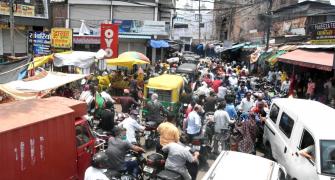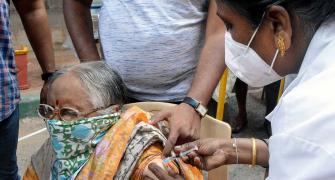The fall in urban sentiments in June is worrisome, observes Mahesh Vyas.

After two gruelling months under the shadow of the second wave of COVID-19, India made substantial progress in June 2021.
The unemployment rate fell and the employment rate rose compared to the levels of May 2021.
COVID-19 infections and deaths dropped perceptibly, six million salaried jobs came back, foreign portfolio investors returned to pour in $1.5 billion into the Indian equity markets and the stock markets continued to scale up new stratospheric levels.
Tax collections improved and the finance minister announced measures to battle consequences of the second wave of COVID-19.
But the Indian consumer remained resolutely unimpressed.
The index of consumer sentiments fell by 1.5 per cent in June 2021 after having fallen by 10.8 per cent in May and 3.8 per cent in April 2021.
The second COVID-19 wave took a heavy toll on households.
Cumulatively, consumer sentiments dropped a substantial 15.4 per cent between March and June 2021.
Improvement in employment or the news in June did not reverse the negativity of Indian households.
Ironically, while 7.5 million out of the 7.8 million jobs added during June 2021 were in urban India, consumer sentiments declined in urban India and not in rural India.
The index fell 4.3 per cent in urban India.
In rural India it gained a negligible 0.4 per cent. Perhaps, the quality of urban jobs regained in June was poor compared to jobs lost earlier.
Or, it would take a lot more to repair the battered sentiments of the consumer.
It was an 8.8 per cent fall in the index of current economic conditions in urban India that was most responsible for the fall in the overall index of consumer sentiments.
The index of current economic conditions comprises answers to two questions posed to household respondents -- how's your household income compared to a year ago and, how are these times compared to a year ago to buy consumer durables.
Both these measures deteriorated in June in urban India.
The proportion of urban households that claimed that their incomes were higher than a year ago dropped from 4.9 per cent in May to 4 per cent in June and those that said that incomes worsened increased from 51.4 per cent to 52.3 per cent.
Similarly, the proportion of urban households that said that it was a better time to buy consumer durables declined from 3.9 per cent in May to 2.4 per cent and those that believed it was a worse time increased from 55 per cent to 61.2 per cent.
In similar comparisons, rural households reported an improvement on the income front.
Yet, they displayed negative sentiments towards purchase of consumer durables.
The proportion of rural households that reported an improvement in their incomes over a year ago rose from 3 per cent in May to 4.1 per cent in June and those that reported a decline fell from 53.5 per cent to 50 per cent.
However, this small improvement on the income front had no impact on the rural folks' decisions to buy durables.
Rural households that believed that this was a better time than a year ago fell from 2.6 to 2.5 per cent but those that believed that this was a worse time rose sharply from 54.5 per cent in May to 61 per cent June.
In urban India, most major income groups reported a fall in the proportion of households that claimed an increase in their income.
The fall was the sharpest in the relatively richer households.
In June 2021, only 7.2 per cent of the urban households that earn more than a million rupees a year reported an increase in income over a year.
In April and May this proportion was 17.1 per cent. In households that earned between half a million and a million rupees a year the fall was from 12.6 per cent in May 2021 to 9 per cent in June.
The fall was smaller for households with lower incomes, but the proportion of households that reported an increase in income is also very low, in low single digits.
This fall in perceptions regarding household income perhaps, had a telling impact on households' willingness to buy consumer durables.
Every major household income group in urban India saw significant deterioration in their desire to buy consumer durables in June 2021 compared to the status in May 2021.
Recovery of the Indian economy from the steep fall it suffered in 2020-21 depends upon an improvement in the perception that households have regarding their own wellbeing and their willingness to spend on non-essentials.
This is particularly important because the government seems unwilling to increase its spending and private enterprise, given its large unutilised capacities, has no logical reason to do so.
During the second COVID-19 wave, spending on essentials was not curtailed like it was during the first wave.
Therefore, the recovery is less likely to depend upon a release of pent-up demand.
The fall in urban sentiments in June is therefore worrisome.
Consumer sentiments in rural India did not shine in June ,but it remained stable.
Consumer goods companies continue to remain sanguine on rural demand in 2021-2022.
However, such optimism faces some headwinds.
The southwest monsoon stalled towards end June. Kharif sowing till June 24 showed a 21 per cent fall compared to a year ago.
A recovery is possible but, it cannot be taken for granted.














